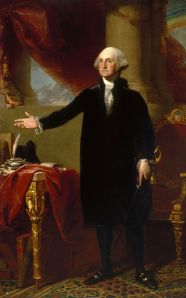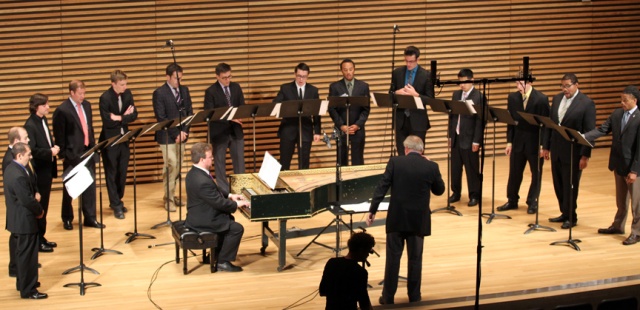Backstage at the Pioneer Center for the Performing Arts in Reno, Nevada and just prior to the 4 p.m. March 17, 2013 premiere of Michael Gandolfi’s orchestral tone poem Chesapeake: Summer of 1814 with the Reno Philharmonic Orchestra and conductor Laura Jackson, I had a chance to chat with the project’s director/designer Anne Patterson.
CLAGUE: What do you see as your role as director/designer for Chesapeake specifically and, more generally, to enhance the audience experience for orchestral music?

Chesapeake Visual Designer and Dramatist Anne Patterson
PATTERSON: Well with orchestras I’m often working on a more traditional piece such as Bach’s St. Mathew Passion, and in that, actually, I am trying to tell a story, or help tell a story. And with Chesapeake, I didn’t really realize it until I started working on it, but my real role was to help tell this incredible tale that [composer] Michael [Gandolfi] has put to music. So I really felt like my visuals could help educate the audience as to what was going on.
CLAGUE: Did you know much about the story about the Chesapeake Campaign before you started the project?
PATTERSON: No, I knew nothing about the story.
CLAGUE: So it’s been an education for you too?
PATTERSON: Super educational! And really inspirational, because you sort of think: ok, yeah, Star Spangled Banner, hmmmmm… I love this country very much, and I feel like a real American, but I’m very skeptical of patriotism, because I think sometimes (and I think a lot of us feel this way) that patriotism can justify acts that I don’t agree with or believe in. And so it was a little bit funny when I contemplated working on a project with which the Star Spangled Banner was the theme.
CLAGUE: So are there moments where the visuals either emphasize a certain part of the story or try to make the audience think a little bit more deeply to get away from any sort of facile, simplistic patriotism?
PATTERSON: We have illustrated, as best we can, what’s going on in terms of the trajectory of the tale. And we decided early on that for the first 4/5th of the piece we’d limit our palate to etchings, and then abstract paintings. The etchings are historical images, done at the time, or soon after, these events.

One of the etching Patterson uses, here depicting the British burning public buildings in Washington, D.C.
CLAGUE: So the visuals give the audience the feeling of history right away.
PATTERSON: Exactly.
CLAGUE: Can you talk a little bit about how you distinguish between the two choirs? One group of singers represent the British troops and another performs as the American troops.

Half of the chorus representing the American militiamen, identified by dress, color, and lighting design to clarify the tone poem’s narrative.
PATTERSON: Yes, that was something that happened really early on when Michael was just starting to compose. And [librettist] Dana [Bonstrom] had done this whole layout, this whole synopsis, and it just felt, to me, a bit confusing. I read through it many times and I still didn’t quite get it. So I said to Michael, “You know what would be really great, is if we had separate choirs to help us follow the story—one to represent the Americans and a second for the British.” And for the most part, Michael was able to stick with that. And I think that was a challenging thing for him, because dividing the chorus in half obviously means half the vocal volume. But for almost all the songs, except for maybe “Rule Britannia” and a couple other places, they are separate. And I think it really helps to tell the tale. And we have this great lighting designer—Don Smith—who has designed some lighting effects. There are stars and stripes behind the Americans, and the Union Jack behind the British the first time they each sing to establish their identities. And I put red sashes on the British soldiers, and they’re all in black. And the Americans are all in shades of blue – different shades so they look a little bit more mismatched, like a civilian militia you know, which I think helps too. So I think all these things together help bring the story to the audience. Like anything, it’s not just one thing that makes it clear, it’s having all this information together, and the audience goes, “Oh, I get it.”
CLAGUE: Do you avoid references to contemporary politics?
D. You know at the very end when we are all singing “The Star Spangled Banner” – the entire audience, the orchestra, and the whole chorus — then we do have a whirlwind of imagery including both contemporary and old images — a whole mish-mash of different stuff. And I think we’ve done, actually, a really good job of including stuff that will appeal to everybody. I mean I think there will be some images that some people are like, “That’s not really me, but I get that,that’s why the flag is also there,” and some people will be like, “Ah, that means so much to me.” It’s pretty emotional.
CLAGUE: Because we have a diverse country–a lot of different people all can be patriotic under one flag. It is emotional.
PATTERSON: Exactly. It’s super emotional. I couldn’t believe how emotional it was! We’ve been working so hard on it, and we’ve been so focused. For the first time I really experienced the piece at the dress rehearsal. I was sitting near [Reno Philharmonic President] Tim [Young], and we were all just trying to pretend we weren’t wiping tears from our eyes. But it was emotional. It’s very emotional.
CLAGUE: Is there a particular moment that gets you?
PATTERSON: I think it’s the end. I think it really is the end. When Key is saying those words, and then you think of this young man who is a prisoner of war on a ship, and then coming out in the smoke. And I think that Michael’s just done such a great job of setting us up to get to that point, that when we get there we’re like: “Oh my God, is the flag really still there?” And of course we all know that the flag is still there; that’s what the song is about. But it’s really exciting, and it’s really emotional.
CLAGUE: That is a fascinating effect, because it is already a story that everybody knows. But we know the basics, not the details. Emotionally we can lose the connection to the raw power of the original moment of Key’s inspiration.
PATTERSON: What really struck me was that I’ve always thought that 1776 — ok, that’s when we declared our independence, and then, of course, we had the War of Independence — but I always sort of felt like once we got through that, we were this independent nation and we were en route to be who we are. But after learning about the War of 1812 I realized that that’s not true at all. The British did not consider this, “Yes, this is all said and done,” but “We’re still here, and we still could really get you back.” The fact that they came and burned down the White House, I never knew that.
CLAGUE: Absolutely. If the British had won the Battle of Baltimore, we just might be in Canada right now.
PATTERSON: Right. I mean, you’re a history professor so you know better, but for a lay person like myself, and just following my memories of American history, I don’t know if I’ve ever truly realized that; I know I didn’t realize that.
CLAGUE: We probably don’t talk enough about the War of 1812. It’s not that glorious moment which creates a sense of pride. After all, the British burned our capital to the ground.
PATTERSON: But in the end we won! It’s just the fact that the war for independence went on for so long, that it didn’t just end with the Declaration of Independence. There was a lot more to come in our history.
CLAGUE: So, how do you handle patriotic imagery with such subtlety and emotional power? I mean, if you ask, “What colors am I going to use?” the easy answer is going to be too obvious and simplistic — “Well I guess red, white and blue.”

An engraving depicting westward expansion as displayed during Chesapeake and showing the sepia toned screen with a shadow image of the USA’s 15-stripe flag that was flying over Fort McHenry and inspired Key’s lyric.
PATTERSON: Well, one interesting thing we did was to create a custom screen for the projections. We use a flag hanging above the stage as the screen. It’s a[n American] flag in sepia tones. So we have the area where the stars would be, but it’s just a blank area. And then we have this faint echo of fifteen stripes from the 1812 flag. And we have the stripes done in, like a pale grey and then a whiter grey. And so that’s our backdrop.
CLAGUE: It’s really beautiful, the way all the images get overlaid on top of that, so you see that flag coming through every picture.
PATTERSON: Right, exactly. So you have the stripes coming through on every single image. And in terms of patriotic expression, in most cases theses are etchings, so you’ve got to remember they didn’t have photography back then, so this was their way to capture the history of what had happened – or not even history at this stage, just the events that had happened. I imagine that some of these etchings were probably in periodicals and newspapers to give everyone an understanding of what was happening; they were like their photographs. So I don’t feel that they’re that patriotic, actually. I feel they’re kind of really more telling the tale. The patriotic stuff does come through at the end. And we did, as I said, try to do a wide version of things. Early in the process, we had some kitschier images in there. We had Superman and we had Wonder-woman, and you know, where the flag was on them. But Michael just said, “I don’t think that’s the way we really want to go.”
CLAGUE: Yeah, he told me he was looking for something quite solemn, and quite introspective.

A Fourth of July cake is among Patterson’s imagery, connecting Gandolfi’s music to the everyday American experience.
PATTERSON: Very solemn, and so it was great actually: we sat down together and we went through them. And some of them that I thought he might nix, like there’s a close-up photograph of a cake and it’s decorated as the American flag, but he liked that because that was still celebrating. He just didn’t want anything that, like you said, fluffed it up— you know what I mean?
CLAGUE: So you and [your assistant] Loring [McAlpin] found all the images and you ran them by Michael?
PATTERSON: Yeah and we laid it all in. And, you know, Michael is such a wonderful collaborator. After the first rehearsal, he came to me and said, “I need to talk to you about this. There’s just some imagery there.” And I said, “Great, let’s fix it.” And that’s just part of collaboration, you know?
CLAGUE: How much has changed this week in rehearsal?
PATTERSON: A ton because we hadn’t even heard all of the music yet…. I would say that probably a third of the content is the same and two thirds has been changed. Which is amazing, actually, now that I think of it.
CLAGUE: What are your favorite images? Do you have favorites?

Patterson’s favorite image — pop star Beyoncé singing in front of a spangled banner
PATTERSON: You know it’s funny, there’s one of Beyoncé that I just really love. It almost makes me cry. I mean it’s pop, it’s our pop culture, but she just looks amazing right in front of the flag. The way she’s standing, the stripes are right behind her, and she looks really great. There’s another really great one where the flag is a full, giant flag that fills up an entire football stadium, and that one’s really pretty great. There are the ones that we all know: there’s one in front of the Vietnam Memorial, which is, of course, upsetting; there’s one in Afghanistan, which I think some of us have seen; there’s a 9/11 image. You know, there’s the cake. I’m trying to think of some of the lighter ones. There’s one of Obama, in which he looks really happy — he’s not super solemn.
CLAGUE: How did you decide the timing of each image, when images are switched? Is it just your personal response to the music?
PATTERSON: It just goes right with the music. I think that’s super important and that’s one of my goals — to always have the imagery, whether it’s abstract or super realistic, to really have it sync with the music. And we also worked really hard to have it sync with the supertitles too, so they are all working together. And we talked to the guys who were doing the supertitles a lot, so that we were like, “Ok, exactly on this note. This is when everybody’s changing at the same time.” It’s a lot of information to coordinate.
CLAGUE: So there’s actually a live performer of the video imagery, right? Someone who is following the score and cueing the images. Every performance is necessarily slightly different in terms of timing. But your conception is also a bit like a movie score in that your goal is to have perfect synchronization of image and sound, but here it’s a live performance not a pre-recorded soundtrack, so it has to be adjusted on the fly.
PATTERSON: Yes, we have a stage manager who’s doing art and imagery. And the supertitles have their own operator. So hopefully we’re all on the same page. Well, we know we’re on the same page. This is also the same with lighting, ’cause there are different lighting cues that happen. But yeah, it’s been working really well.
CLAGUE: Anything else you want to be sure we discuss?
PATTERSON: I just think it’s a really great piece for everybody. Chesapeake really celebrates who we all are as Americans in this country, regardless of whether you’re liberal or conservative. It represents all our views. So I think that’s what’s really exciting about it. I think that it will open up a lot of people’s eyes. It opened my eyes to look at not only the history of it, but also the content of it.
CLAGUE: Well, thank you so much for sharing your thoughts and insights. I’m really looking forward to hearing and seeing the performance!
Special thanks to SSMF intern and research assistant Ellen Sauer for her help with the transcription!





















